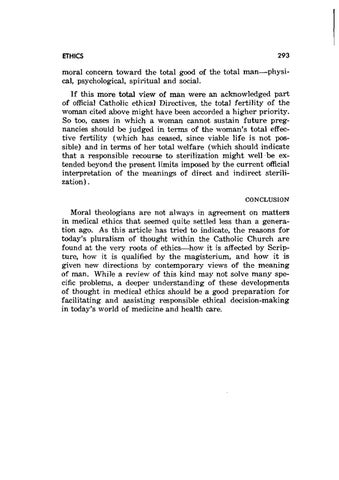ETHICS
293
moral concern toward the wtal good of the total man-physical, psychological, spiritual and social. If this more wtal view of man were an acknowledged part
of official Catholic ethical Directives, the total fertility of the woman cited above might have been accorded a higher priority. So too, cases in which a woman cannot sustain future pregnancies should be judged in terms of the woman's total effective fertility (which has ceased, since viable life is not possible) and in terms of her total welfare (which should indicate that a responsible recourse to sterilization might well¡ be extended beyond the present limits imposed by the current official interpretation of the meanings of direct and indirect sterilization). CONCLUSION
Moral theologians are not always in agreement on matters in medical ethics that seemed quite settled less than a generation ago. As this article has tried to indicate, the reasons for today's pluralism of thought within the Catholic Church are found at the very roots of ethics-how it is affected by Scripture, how it is qualified by the magisterium, and how it is given new directions by contemporary views of the meaning of man. While a review of this kind may not solve many specific problems, a deeper understanding of these developments of thought in medical ethics should be a good preparation for facilitating and assisting responsible ethical decision-making in today's world of medicine and health care.
